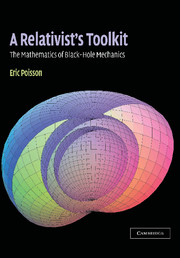2 - Geodesic congruences
Published online by Cambridge University Press: 02 December 2009
Summary
Our purpose in this chapter is to develop the mathematical techniques required in the description of congruences, the term designating an entire system of nonintersecting geodesics. We will consider separately the cases of timelike geodesics and null geodesics. (The case of spacelike geodesics does not require a separate treatment, as it is virtually identical to the timelike case; it is also less interesting from a physical point of view.) We will introduce the expansion scalar, as well as the shear and rotation tensors, as a means of describing the congruence's behaviour. We will derive a useful evolution equation for the expansion, known as Raychaudhuri's equation. On the basis of this equation we will show that gravity tends to focus geodesics, in the sense that an initially diverging congruence (geodesics flying apart) will be found to diverge less rapidly in the future, and that an initially converging congruence (geodesics coming together) will converge more rapidly in the future. And we will present Frobenius' theorem, which states that a congruence is hypersurface orthogonal – the geodesics are everywhere orthogonal to a family of hypersurfaces – if and only if its rotation tensor vanishes.
The chapter begins (in Section 2.1) with a review of the standard energy conditions of general relativity, because some of these are required in the proof of the focusing theorem. It continues (in Section 2.2) with a pedagogical introduction to the expansion scalar, shear tensor, and rotation tensor, based on the kinematics of a deformable medium. Congruences of timelike geodesics are then presented in Section 2.3, and the case of null geodesics is treated in Section 2.4.
- Type
- Chapter
- Information
- A Relativist's ToolkitThe Mathematics of Black-Hole Mechanics, pp. 28 - 58Publisher: Cambridge University PressPrint publication year: 2004

